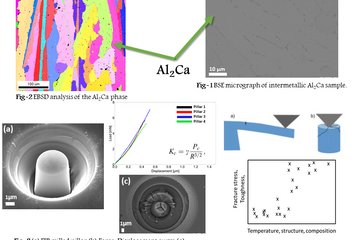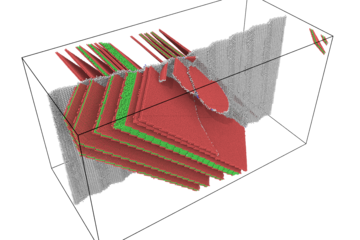All genres
901.
Journal Article
Processing, microstructure, and properties of ternary high-strength Cu–Cr–Ag in situ composites. Material Science and Engineering A 291, pp. 186 - 197 (2000)
902.
Journal Article
Experimental investigation and Ginzburg-Landau modeling of the microstructure dependence of superconductivity in Cu–Ag–Nb wires. Acta Materialia 47 (3), pp. 769 - 777 (1999)
903.
Journal Article
Experimental investigation and modeling of the influence of microstructure on the resistive conductivity of a Cu–Ag–Nb in situ composite. Acta Materialia 47, pp. 1627 - 1634 (1999)
904.
Journal Article
Simulation of the texture evolution during annealing of cold rolled BCC and FCC matals using a cellular automation approach. Textures and Microstructures 28, pp. 211 - 218 (1997)
905.
Journal Article
Strip casting of stainless steels. Acta Materialia 45, pp. 1137 - 1151 (1997)
906.
Journal Article
Texture simulation for hot rolling of aluminium by use of a Taylor model considering grain interactions. Acta Metallurgica et Materialia 43 (3), pp. 1023 - 1028 (1995)
907.
Journal Article
Rolling and recrystallization textures of bcc steels. Steel Research 62 (12), pp. 567 - 575 (1991)
908.
Book
Crystal Plasticity Finite Element Methods in Materials Science and Engineering. Wiley-VCH, Weinheim (2010), 197 pp.
909.
Book
Computational Materials Engineering – An Introduction to Microstructure Evolution. Academic Press, Elsevier, USA (2007), 360 pp.
910.
Book
Continuum Scale Simulation of Engineering Materials Fundamentals - Microstructures - Process Applications. WILEY-VCH, Weinheim (2004), 855 pp.
911.
Book
Computational Materials Science - The Simulation of Materials Microstructures and Properties. Wiley-VCH (1998), 402 pp.
912.
Book Chapter
Iron-rich High Entropy Alloys. In: High-Performance Ferrous Alloys, pp. 389 - 421 (Ed. Rana, R.). Springer Nature Switzerland, Cham, Switzerland (2021)
913.
Book Chapter
Spectral Solvers for Crystal Plasticity and Multi-physics Simulations. In: Handbook of Mechanics of Materials, pp. 1347 - 1372 (Eds. Hsueh, C.-H.; Schmauder, S.; Chen, C.-S.; Chawla, K. K.; Chawla, N. et al.). Springer, Singapore (2019)
914.
Book Chapter
Recovery and Recrystallization: Phenomena, Physics, Models, Simulation. In: Physical Metallurgy: Fifth Edition, Vol. 1, pp. 2291 - 2397. Elsevier Inc., New York, NY, USA (2014)
915.
Book Chapter
Interface segregation in advanced steels studied at the atomic scale. In: Microstructural Design of Advanced Engineering Materials, pp. 267 - 298 (Ed. Molodov, D. A.). Wiley-VCH Verlag GmbH & Co. KGaA, Weinheim, Germany (2013)
916.
Book Chapter
Multi‐scale Modelling of a Biological Material: The Arthropod Exoskeleton. In: Materials Design Inspired by Nature: Function Through Inner Architecture (CHAPTER 9), pp. 197 - 218 (Eds. Fratzl, P.; Dunlop, J.W.C.; Weinkamer, R.) (2013)
917.
Book Chapter
Ab Initio Guided Design of Materials. In: Structural Materials and Processes in Transportation, pp. 481 - 495 (Eds. Lehmhus, D.; Busse, M.; Herrmann, A. S.; Kayvantash, K.). Wiley-VCH Verlag GmbH & Co. KGaA, Weinheim, Germany (2013)
918.
Book Chapter
Crystal Plasticity Modeling. In: Microstructural Design of Advanced Engineering Materials, 3, pp. 41 - 57 (Ed. Molodov, D. A.). Wiley-VCH Verlag GmbH Co. KGaA, Weinheim (2013)
919.
Book Chapter
Hierarchical modeling of biological nanocomposites. In: Mechanics of Nanomaterials and Nanotechnology, pp. 199 - 224 (Eds. Kavardzhikov, V.; Parashkevova, L.; Baltov, A.). Institute of Mechanics - BAS, Sofia, Sofia, Bulgaria (2012)
920.
Book Chapter
Chitin in the exoskeletons of arthropoda: From ancient design to novel materials science. In: Chitin, pp. 35 - 60 (Ed. editor), N. S. G. (.). Springer, Germany (2011)











